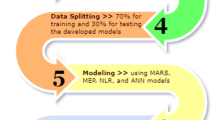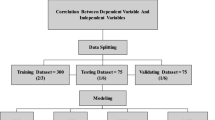Abstract
A multi-scale experimental study was carried out to investigate the porosity, flexural and compressive strengths of cement-mortar at different cement strength classes (CSCs). Specifically, 54 mix designs (totally 324 specimens) were first defined and then the produced cement-mortar specimens were tested to consider their properties. To identify the microstructure of the specimens at different conditions, scanning electron microscope (SEM) imaging and energy dispersive spectroscopy (EDS) analysis were also performed. The results show that the porosity, and flexural and compressive strengths change significantly at different CSCs. At the same mix proportion, the cement-mortar has lower porosity as well as higher flexural and compressive strengths as the CSC gets higher. Considering the combined effects of various parameters on the mentioned properties, a new multi-objective model using artificial neural network (ANN) was proposed to analyze the experimental data of porosity, and flexural and compressive strengths. The results show that the proposed model is able to provide predictions with good accuracy.



















Similar content being viewed by others
Abbreviations
- ANN:
-
Artificial neural network
- MLP:
-
Multilayer perceptron
- P :
-
Porosity
- F f :
-
Flexural strength
- F c :
-
Compressive strength
- SEM:
-
Scanning electron microscope
- EDS:
-
Energy dispersive spectroscopy
- C:
-
Cement
- CSC:
-
Cement strength class
- W/C:
-
Water to cement ratio
- S/C:
-
Sand to cement ratio
- HRWR:
-
High range water reducer
- MSE:
-
Mean square error
- MAPE:
-
Mean absolute percentage error
- R 2 :
-
Coefficient of determination
- W w :
-
The weight of saturated specimen
- W ssd :
-
The specimen weight in the saturate surface dry
- W d :
-
The specimen dry weight after 24 h in oven
- LM:
-
Levenberg–Marquardt
- traingda:
-
Gradient descent with adaptive learning rate
- traingdx:
-
Gradient descent with momentum and adaptive learning rate
- trainscg:
-
Scaled conjugate gradient
- x i :
-
The input signal of n external node to a node j
- \(\theta_{j}\) :
-
The activation threshold of the node j
- w ij :
-
The connection weight between the ith external node
- f :
-
The activation function
- y i :
-
The output of node
- v j :
-
The connection weight for the feedback
References
ElNemr, A.: Generating water/binder ratio-to-strength curves for cement mortar used in Masnory walls. Constr. Build. Mater. 233, 117249 (2020)
MolaAbasi, H.; Saberian, M.; Li, J.: Prediction of compressive and tensile strengths of zeolite-cemented sand using porosity and composition. Constr. Build. Mater. 202, 784–795 (2019)
Eskandari, H.: Designing, proposing and comparing the methods predicting the compressive strength of the ferro cement mortar. Concr. Res. Lett. 6(1), 1–10 (2015)
Ferrara, L., et al.: Recycling ceramic waste powder: effects its grain-size distribution on fresh and hardened properties of cement pastes/mortars formulated from SCC mixes. J. Sustain. Cement Based Mater. 8(3), 145–160 (2019)
Eskandari-Naddaf, H.; Kazemi, R.: Experimental evaluation of the effect of mix design ratios on compressive strength of cement mortars containing cement strength class 425 and 525 MPa. Procedia Manuf. 22, 392–398 (2018)
Chandra, S.; Björnström, J.: Influence of cement and superplasticizers type and dosage on the fluidity of cement mortars—Part I. Cem. Concr. Res. 32(10), 1605–1611 (2002)
Haach, V.G.; Vasconcelos, G.; Lourenço, P.B.: Influence of aggregates grading and water/cement ratio in workability and hardened properties of mortars. Constr. Build. Mater. 25(6), 2980–2987 (2011)
Dadsetan, S.; Bai, J.: Mechanical and microstructural properties of self-compacting concrete blended with metakaolin, ground granulated blast-furnace slag and fly ash. Constr. Build. Mater. 146, 658–667 (2017)
Türker, H.T., et al.: Microstructural alteration of alkali activated slag mortars depend on exposed high temperature level. Constr. Build. Mater. 104, 169–180 (2016)
Ozturk, A.U.; Baradan, B.: A comparison study of porosity and compressive strength mathematical models with image analysis. Comput. Mater. Sci. 43(4), 974–979 (2008)
Tanyildizi, H.: The investigation of microstructure and strength properties of lightweight mortar containing mineral admixtures exposed to sulfate attack. Measurement 77, 143–154 (2016)
Duan, Z.-H.; Kou, S.-C.; Poon, C.-S.: Using artificial neural networks for predicting the elastic modulus of recycled aggregate concrete. Constr. Build. Mater. 44, 524–532 (2013)
Ince, R.: Prediction of fracture parameters of concrete by artificial neural networks. Eng. Fract. Mech. 71(15), 2143–2159 (2004)
Alshihri, M.M.; Azmy, A.M.; El-Bisy, M.S.: Neural networks for predicting compressive strength of structural light weight concrete. Constr. Build. Mater. 23(6), 2214–2219 (2009)
Khan, M.I.: Mix proportions for HPC incorporating multi-cementitious composites using artificial neural networks. Constr. Build. Mater. 28(1), 14–20 (2012)
Akkurt, S., et al.: The use of GA–ANNs in the modelling of compressive strength of cement mortar. Cem. Concr. Res. 33(7), 973–979 (2003)
Hamid Eskandari-Naddaf, H. and R. Kazemi, ANN prediction of cement mortar compressive strength, influence of cement strength class. Construction and Building Materials, 2017. 138: p. 1–11.
Kooshkaki, A.; Eskandari-Naddaf, H.: Effect of porosity on predicting compressive and flexural strength of cement mortar containing micro and nano-silica by multi-objective ANN modeling. Constr. Build. Mater. 212, 176–191 (2019)
Basheer, I.; Hajmeer, M.: Artificial neural networks: fundamentals, computing, design, and application. J. Microbiol. Methods 43(1), 3–31 (2000)
Walczak, S.: Artificial neural networks. In: Advanced Methodologies and Technologies in Artificial Intelligence, Computer Simulation, and Human-Computer Interaction, IGI Global. p. 40–53 (2019).
ASTM, C.: 778: Standard specification for standard sand. Annual Book of ASTM Standards (2006)
Shah, A., et al.: Effect of high range water reducers (HRWR) on the properties and strength development characteristics of fresh and hardened concrete. Iran. J. Sci. Technol. Trans. Civil Eng. 37(1), 513 (2013)
ASTM, A: Standard specification for flow table for use in tests of hydraulic cement. ASTM, West Conshohocken, PA (2014)
Standard, A.: C305. Standard Practice for Mechanical Mixing of Hydraulic Cement Pastes and Mortars of Plastic Consistency. ASTM International, West Conshohocken, PA: (2012)
ASTM, C.: 642, Standard Test Method for Density, Absorption, and Voids in Hardened Concrete. Annual book of ASTM Standards (2006)
ASTM, C.: 348–97. Standard Test Method for Flexural Strength of Hydraulic-Cement Mortars. Annual book of ASTM (2002)
ASTM, C.: 349–97. Standard Test Method for Compressive Strength of Hydraulic-Cement Mortars (Using Portions of Prisms Broken in Flexure). Annual book of ASTM, 2002. 4.
Graupe, D.: Principles of Artificial Neural Networks. Vol. 7. World Scientific (2013)
Jadid, M.N.; Fairbairn, D.R.: Neural-network applications in predicting moment-curvature parameters from experimental data. Eng. Appl. Artif. Intell. 9(3), 309–319 (1996)
Delashmit, W.H. and M.T. Manry. Recent developments in multilayer perceptron neural networks. in Proceedings of the seventh Annual Memphis Area Engineering and Science Conference, MAESC. 2005. Citeseer.
Yu, H.; Wilamowski, B.M.: Levenberg–marquardt training. Ind. Electron. Handbook 5(12), 1 (2011)
Günther, F.; Fritsch, S.: neuralnet: training of neural networks. R J 2(1), 30–38 (2010)
Haykin, S.S., et al.: Neural Networks and Learning Machines, Vol. 3. Pearson, Upper Saddle River, NJ (2009)
Prasad, B.R.; Eskandari, H.; Reddy, B.V.: Prediction of compressive strength of SCC and HPC with high volume fly ash using ANN. Constr. Build. Mater. 23(1), 117–128 (2009)
Wei, X.; Xiao, L.; Li, Z.: Prediction of standard compressive strength of cement by the electrical resistivity measurement. Constr. Build. Mater. 31, 341–346 (2012)
Bentz, D.P., et al.: Effects of cement particle size distribution on performance properties of Portland cement-based materials. Cem. Concr. Res. 29(10), 1663–1671 (1999)
Sabdono, P.; Sustiawan, F.; Fadlillah, D.A.: The effect of nano-cement content to the compressive strength of mortar. Procedia Engineering 95, 386–395 (2014)
Domone, P. and J. Illston, Construction materials: their nature and behaviour. 2010: CRC Press.
Kargari, A.; Eskandari-Naddaf, H.; Kazemi, R.: Effect of cement strength class on the generalization of Abrams’ law. Struct. Concr. 20(1), 493–505 (2019)
Qian, C., et al.: Evaluation of sub-microstructure in concrete with low water-binder ratio by SEM-BSE image analysis. J. Wuhan Univ. Technol. Mater. Sci. Ed. 25(4), 682–686 (2010)
Chiang, W.-S., et al.: Microstructural changes of globules in calcium–silicate–hydrate gels with and without additives determined by small-angle neutron and X-ray scattering. J. Colloid Interface Sci. 398, 67–73 (2013)
Author information
Authors and Affiliations
Corresponding author
Rights and permissions
About this article
Cite this article
Kazemi, R., Shadnia, R., Eskandari-Naddaf, H. et al. The Properties of Cement-Mortar at Different Cement Strength Classes: Experimental Study and Multi-objective Modeling. Arab J Sci Eng 47, 13381–13396 (2022). https://doi.org/10.1007/s13369-022-06820-7
Received:
Accepted:
Published:
Issue Date:
DOI: https://doi.org/10.1007/s13369-022-06820-7




